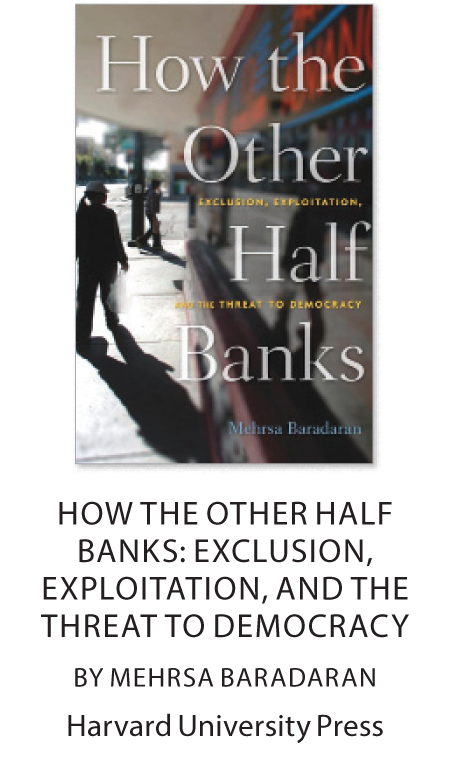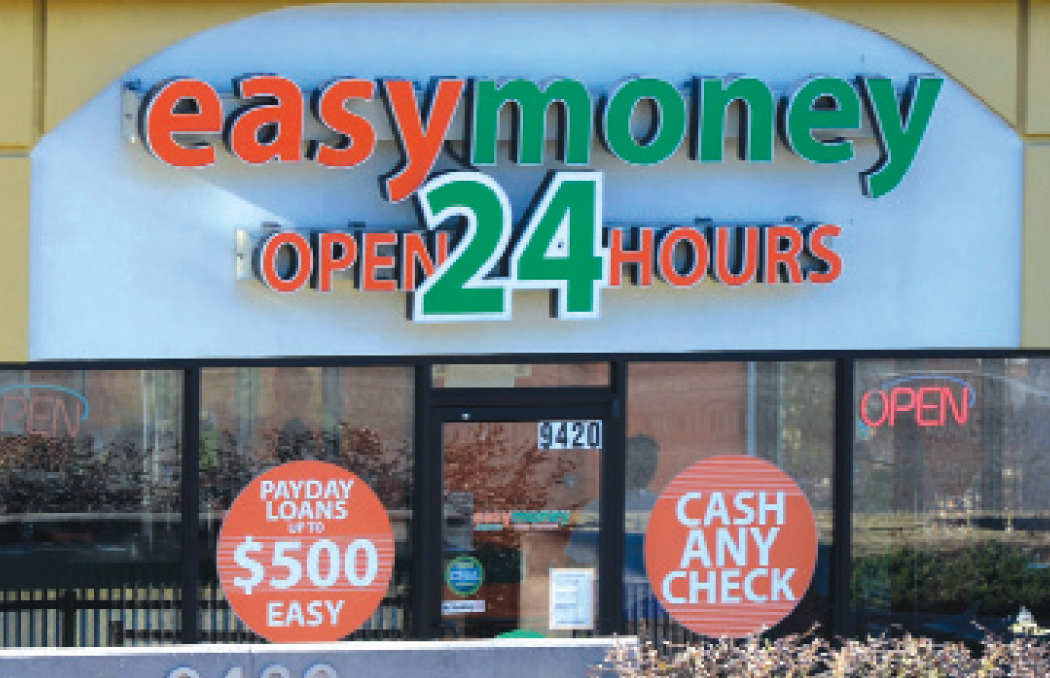The Big Financial Divide
Why we have one banking system for the well-off and a “Wild West” fringe for everyone else
By Lisa J. Servon


The hit Broadway musical Hamilton features a riveting rap throwdown between Thomas Jefferson and Alexander Hamilton called Cabinet Battle #1. The issue on the table? Secretary of the Treasury Hamilton’s proposal to assume the states’ Revolutionary War debt and establish a national bank.
jefferson: But Hamilton forgets
His plan would have the gov-
ernment assume state’s debtsNow, place your bets as to who
that benefits:The very seat of government
where Hamilton sitshamilton: Thomas. That was a
real nice declarationWelcome to the present, we’re
running a real nationWould you like to join us, or stay
mellowDoin’ whatever the hell it is you
do in Monticello?If we assume the debts, the
union getsA new line of credit, a financial
diureticHow do you not get it? If we’re
aggressive and competitiveThe union gets a boost. You’d
rather give it a sedative?
Jefferson wanted a system of small, local banks to support the farmers who constituted the backbone of the economy, while Hamilton supported a centralized, government-coordinated banking system. The very same debate features prominently in the second chapter of Mehrsa Baradaran’s important and comprehensive new book, How the Other Half Banks: Exclusion, Exploitation, and the Threat to Democracy. Hamilton did get the federal government to assume state debt and create a short-lived national bank. But Jefferson’s position prevailed through the 19th century and remained a powerful influence even into the 20th. Not only were banks small and local, they were also prohibited from engaging in the more complex financial activities in which Wall Street firms specialized. Local versus national; small and accessible versus large and efficient—these debates have been rehashed in different ways at different times over the 220 years since Hamilton left that office, and Baradaran chronicles them all.
How the Other Half Banks is a fascinating read, and Baradaran has done a masterful job of turning what could be incredibly dry material into a well-paced, accessible chronicle of how the consumer financial services industry has changed since the beginning of the republic. She traces the history of the relationship between the banking industry and the nation, and shows how banks have gained more power, leaving the less well-off excluded and exploited. As a result, she writes, we are now left with “two banking systems in America: government-supported banks that serve the well off, and a Wild West of fringe lenders and check-cashing joints that answer the needs of everyone else—at a hefty price.”
Baradaran, an associate professor at the University of Georgia School of Law, explains the social contract that exists between banks and the government, a contract that rests on their interdependence. “For hundreds of years,” she writes, “this country’s leaders were afraid of excessive bank power and the inequalities of access it would inevitably produce.” Thomas Jefferson, John Adams, and others disdained banks and worried that they had too much power. Supreme Court Justice Louis Brandeis wanted to turn them into public utilities like the railroads. But over time, that contract has become “lopsided,” increasingly tilted in favor of the banks.
Baradaran details the efforts that have been made to provide safe, affordable financial services to everyone. She chronicles early postal banking (which she calls “the largest and most successful experiment in financial inclusion in U.S. history”), credit unions, community banks, the Freedman’s Savings Bank, Morris banks, and industrial loan companies. She shows that models that succeeded for a time were heavily subsidized. Although all were well-intentioned, each and every one of these attempts eventually strayed from the public purpose to which they had originally been committed.
Perhaps the most important change to the social contract came during the past few decades, when banks began to lose customers—and profitability—as consumers turned increasingly to other kinds of financial services providers. Government responded by deregulating banks, enabling their unchecked growth. Deregulation and the growth it facilitated also allowed banks to make money in new ways—through complex investment strategies and international deals, for example. As a result, they turned away from ordinary consumers because more money was to be made elsewhere.
Banks also began to fail more often during this period and, rather than let them fail, government stepped in to bail them out. Congressman Stewart McKinney coined the term “too big to fail” in 1984—24 years before the financial crisis that made it a commonplace catchphrase. McKinney used the term in a congressional hearing discussing the decision of the Federal Deposit Insurance Corporation (FDIC) to bail out Continental Illinois, the largest bank failure in U.S. history up until that time. The situation has only worsened since then. When Washington Mutual went under during the financial crisis in 2008, the bank was seven times larger than Continental Illinois had been. As they deregulated, banks adopted the attitude that they didn’t owe the public anything; the definition of “public interest” changed from equality of access to profitability and efficiency.
In the tradition of the Founders, Baradaran argues that banks should reciprocate the advantages granted them by the state—for example, insurance, liquidity protection, bailouts, advances from the Federal Reserve—by providing safe, affordable financial services to all Americans. And yet banks have moved further away from keeping up their end of the bargain, and the nation’s leaders have not held them to it. We saw that pattern most strikingly in the wake of the most recent financial crisis when, “instead of using the crisis to effect real reform in banking … policymakers focused myopically on maintaining bank profitability without requiring anything in return.”
Banks have been particularly unfriendly to people of color and women, who have endured credit discrimination throughout history. Despite a spate of legislation passed in the wake of the civil-rights era, African Americans still get less-favorable credit than whites who have the same credit profiles. They lost more than any other group as a result of the financial crisis, and they are more likely to be targeted by debt collectors than are whites.
We’re at a place in our political history that makes it seem unlikely that government will rethink the “quid pro quo bargain” that has always existed between banks and the government but, in the modern era, does not hold banks accountable for the risks they take and the people they exclude. Baradaran implies that it’s too late to “make banking boring again,” as Paul Krugman mused in 2009. She believes we should turn elsewhere for solutions, namely to the postal service.
In the final chapter of How the Other Half Banks, Baradaran argues that the problem of financial exclusion should be solved by a reinvention of the postal banking system that we had in the 50 years before 1967. Although the idea has its merits, Baradaran’s argument is less than convincing. The 2014 white paper produced by the U.S. Postal Service Office of Inspector General, on which Baradaran bases her recommendation, leaves too many critical questions unanswered, and she fails to address them sufficiently. She claims that the Postal Service can use natural economies of scale and scope. But in the last several years, post offices have been shutting down and decreasing their hours, while check cashers and payday lenders are increasingly open 24/7. Baradaran also maintains that post offices “would be able to offer products at cost.” But the one financial product they now offer—money orders—costs less at most check cashers than at the post office. The prepaid card and the Postal Loan—a substitute for a payday loan—that the white paper proposes seem attractive on the surface. But the proposal fails to specify how the Postal Service would develop effective risk scorecards for underserved segments of the population, who often require nonstandard approaches. It also does not describe collections routines for delinquent loans, or how its loan model would generate a profit, or even just cover costs. Even nonprofit operations and for-profit businesses with a social-justice bent have had a hard time offering these services at attractively lower prices.
The Postal Service could offer low-cost financial services or it could generate profit, but it would be difficult to serve the poor and “save the [Postal Service] from imminent demise.” The white paper on which Baradaran bases much of her argument maintains that providing credit could enable the Postal Service to turn a profit. That seems unlikely.
In order to evaluate the postal banking proposal, it’s necessary to compare it to check cashers and payday lenders, since those are the places the “unbanked” are currently getting most of their financial needs met. It wouldn’t be too difficult to provide the kinds of services one finds at a check casher—money orders, bill paying, and remittances are not rocket science, and the people who work in these businesses don’t require an advanced education. But with the decline in the number of checks written, the increase in direct deposit, and the growing use of mobile banking technologies, the check-cashing business model is under pressure.
The provision of credit is another matter. The kind of underwriting that’s necessary to make loans to people who have little or no access to the financial mainstream is difficult and complex. It’s not so hard to make payday loans with annual percentage rates of 400 percent and more. Those aren’t the kinds of loans Baradaran is suggesting the Postal Service should make. It’s extremely tricky to do what she is suggesting—to make small loans at reasonable prices to people who likely have problematic credit histories. Making loans that carry even a 36 percent interest rate—a rate that’s considered usurious in some states—is tough to do. Oportun, a small-dollar lender based in California, has spent nearly a decade working to develop underwriting criteria, and turns a modest profit by offering loans at an average annual percentage rate (including fees) of about 38 percent, and by approving approximately half of all loans from new applicants.
How the Other Half Banks tells an important story, one in which we have allowed the profit motives of banks to trump the public interest. Baradaran is right to take a pragmatic approach to these issues, as it seems unlikely that there is sufficient political will to renegotiate the social contract between banks and government so that it once again favors the public.
The retreat of banks from their public responsibilities is a key piece of this story. But there’s a larger, equally important story behind this one. During the same time that deregulation happened, real wages declined, income volatility increased, and the social-welfare safety net got torn to shreds. As a result, a growing number of people simply cannot make ends meet. Even the best public banking system on the planet can’t fix that problem. ![]()
Lisa J. Servon is professor of urban policy and management at the New School. Her forthcoming book, The Unbanking of America, will be published in 2017.